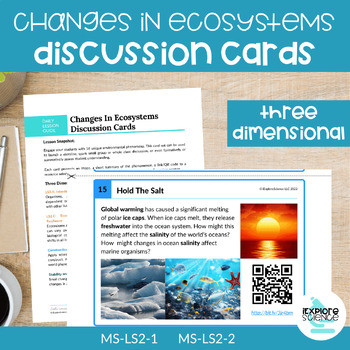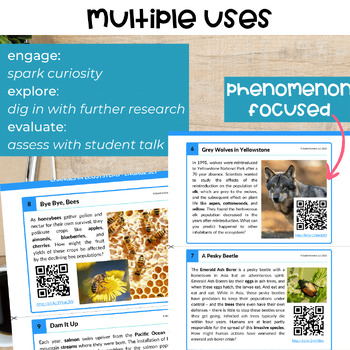Biotic & Abiotic Changes In Ecosystems - Phenomenon Discussion Cards
- PDF
What educators are saying
Description
Engage your students with 16 unique environmental phenomena. This card set can be used to launch a storyline, spark small group or whole class discussion, launch a research project, or even formatively or summatively to assess student understanding. Students are engaged with fascinating real-world examples and given opportunities to write, discuss, and interact with classmates and technology.
Each card presents
- an image,
- a short summary of the phenomenon,
- a link/QR code to a resource selected to expand student understanding of the issue,
- and a discussion prompt.
The card set explores ecology concepts like biological and physical components of ecosystems (aka biotic and abiotic factors), ecological relationships, and changes in ecosystems. The phenomena presented touch on NGSS MS-LS2-1, MS-LS2-2, and MS-LS2-4.
The teacher guide includes a link to a bonus resource pack -- Crosscutting Concepts graphic organizers -- that you can pair with the cards to deepen students exploration of the phenomena!
Learning Targets:
- Students will be able to discuss how changes to physical or biological components of an ecosystem affect populations.
- Students will make predictions about changes in ecosystems.
This lesson includes:
- 16 scenario cards
- teacher lesson guide (2 pages)
- answer key with potential responses
What if I have questions?
You can email me at nvantassel@iexplorescience.com with questions about resources or implementation. I'm happy to help!
Check Out These Related Resources
- Exploring The Kelp Forest Ecosystem Collapse (Investigative Phenomenon)
- Field Notes Food Webs: Producers, Consumers, Decomposers (NGSS MS-LS2-3)
- Biotic and Abiotic Factors -- 5E Activity Bundle (NGSS MS-LS2-4)
- Interactions In Ecosystems Explore Card Sort (NGSS MS-LS2-2)
- Environmental Factors Affect Plant Growth Hands-On NGSS Lab
These activities are part of a unit designed to meet the following standards:
MS-LS2-1 Analyze and interpret data to provide evidence for the effects of resource availability on organisms and populations of organisms in an ecosystem.
MS-LS2-2 Construct an explanation that predicts patterns of interactions among organisms across multiple ecosystems
MS-LS2-4 Construct an argument supported by empirical evidence that changes to physical or biological components of an ecosystem affect populations.
Terms Of Use:
Copyright © 2021, 2023 iExploreScience LLC. All pages of this product are copyrighted, and all rights are reserved by the author. You may not create anything to sell or share based on this packet. The product is created for the use of ONE teacher. Please do not share with colleagues. If they like the product, please send them to my TpT store. I appreciate your support with this request! You are permitted to share ONLY the cover image of this product on your blog or via social media as long as you link back to my product on TpT. Failure to comply is a copyright infringement and a violation of the Digital Millennium Copyright Act (DMCA). Clipart and elements found in this PDF are copyrighted and cannot be extracted and used outside of this file without permission or license. Intended for classroom and personal use ONLY.
*Note: NGSS is a registered trademark of Achieve. Neither Achieve nor the lead states and partners that developed the Next Generation Science Standards were involved in the production of this product, and do not endorse it.





